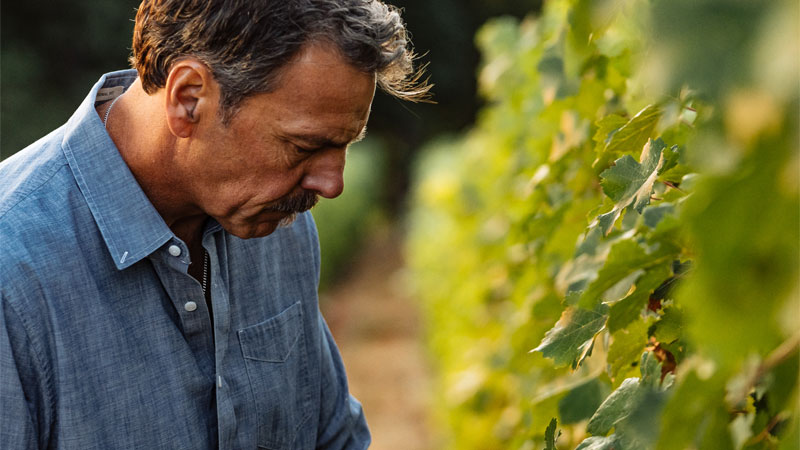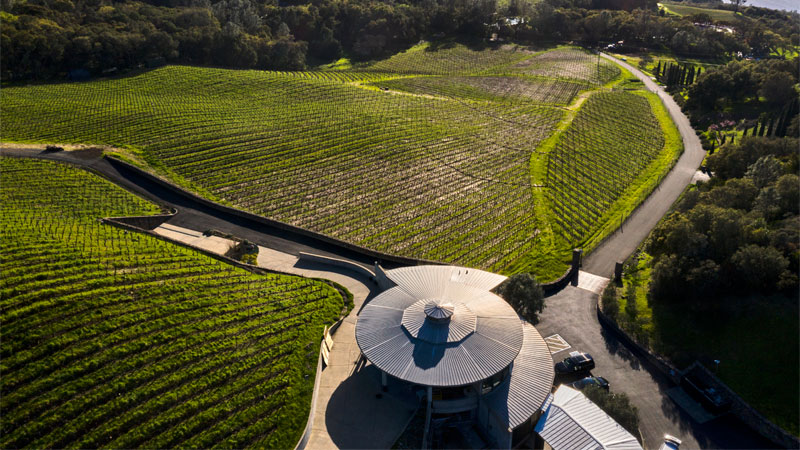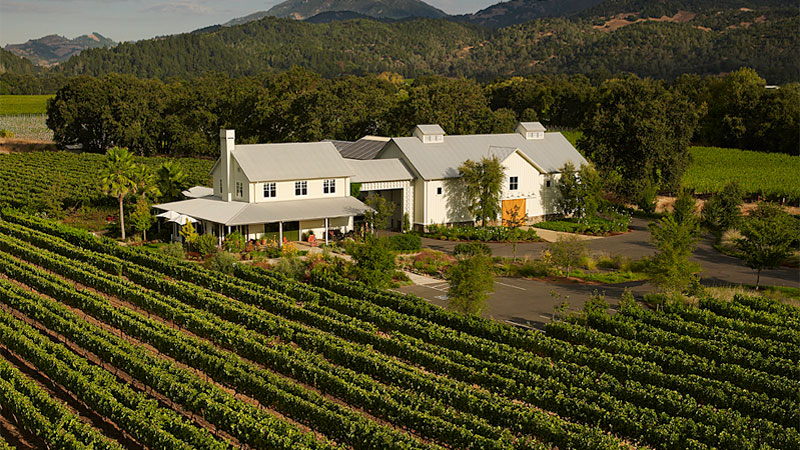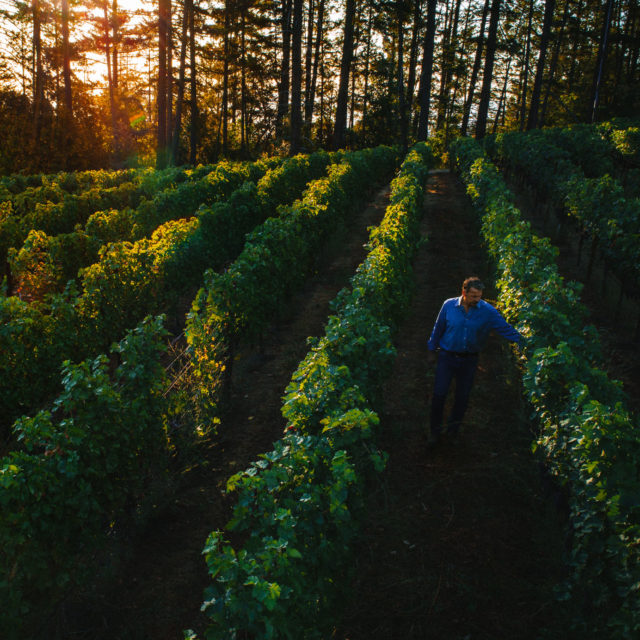Cabernet Sauvignon is indisputably Napa’s premier red grape. But lately, Cabernet Franc has been gaining fresh attention among winemakers in the region. In the past few years, the grape has been making its way in more single-varietal bottlings and blends. Now, as growers plant more vineyards to Cabernet Franc and demand rises, grape prices have followed suit.
Cabernet Franc’s presence in the valley may still be small, but winemakers say they see the grape’s potential. “We have an opportunity to make a really great Cab Franc in the Napa Valley,” says Chris Carpenter, winemaker at La Jota Vineyard Co., which makes a $95 varietal bottling of Cabernet Franc. “We have the right climate, the right soils, and people are starting to pick up on it.”
For consumers, Cabernet Franc hits on multiple levels: It appeals to both classic Bordeaux aficionados, as well as a younger generation that is drawn to the leaner, herbal style found in the Loire. Carpenter reports that drinkers of his Cabernet Francs are recognizing the longevity of the variety and are beginning to think of it as a collectible wine, much like Cabernet Sauvignon.
For wine drinkers interested in getting in on Napa’s Cabernet Franc trend early, here’s what to know.

An Increase in Plantings and Price
The first known Cabernet Franc in the region was planted in 1949 in Detert Vineyard, which was originally part of the To Kalon Vineyard. The original 18-acre site was predominantly Cabernet Franc — approximately 17 acres — largely due to the influence of Robert Mondavi, who purchased much of the fruit.
Although a replant of the west block of that vineyard in 2015 saw a higher percentage of Cabernet Sauvignon plantings go in, third-generation vintner Tom Garrett of Detert Family Vineyards says he has seen an uptick of interest in Cabernet Franc, such as their Oakville Cabernet Franc, which sells for $100. “From our perspective, both from making our own wine and selling grapes, we — as you can imagine — have seen the growth and interest in Cabernet Franc just continue to slowly grow,” says Garrett. “There are a lot of really passionate Cabernet Franc enthusiasts out there.”
Cabernet Franc plantings are small in the region, but are growing. There are currently 1,211 acres of Cabernet Franc to Cabernet Sauvignon’s 24,354 acres. However, Cabernet Franc plantings increased by 13.5 percent from 2006 to 2016, and new projects indicate more to come.
At La Jota Vineyard Co., Carpenter started with a block of Cabernet Franc planted on St. George rootstock. “We still farm that particular piece and it is probably one of the oldest Cabernet Franc blocks in the Napa Valley,” he says. “But we’ve also planted additional Cab Franc up there as the popularity of that particular wine in the La Jota range has grown.” To meet customer demand, La Jota’s initial production of 200 cases quadrupled to almost 900 cases.
Carpenter’s conviction for Cabernet Franc in Napa is reflected in his newest project, Caladan. Aiming to create what he calls a “Right Bank expression” of Cabernet Franc in Napa Valley, he sources his fruit from four distinctive mountain sites — Howell Mountain, Mount Veeder, Diamond Mountain, and Spring Mountain — to produce a notably complex wine that sells for $150.
Meanwhile, Bryant Estate has always used Cabernet Franc from Abreu vineyards in its $500 Bettina blend, but 10 years ago planted a small parcel on the estate’s own Pritchard Hill site. The winery bottled its first single-varietal Cabernet Franc in 2016; it will be released later this year.
One of the biggest indicators of Cabernet Franc’s growing popularity is grape prices. According to the California Department of Food and Agriculture’s 2019 Grape Crush Report, Cabernet Franc commands an average $9,493.79 per ton versus Cabernet Sauvignon at $7,865.52 per ton. This is not a one-off; Cabernet Franc has commanded a higher price point since 2016. While much of that is driven by supply and demand, the fact that there is such a demand speaks to the growing popularity of the grape.

The Business Case for Cabernet Franc
Somewhat a fickle grape, Cabernet Franc “has a mean streak, and it’s a green streak,” says Dan Petroski, winemaker at Larkmead Vineyards. The challenge is this: Pushing Cabernet Franc to full ripeness causes it to lose its nuanced aromas and flavors. But when the grape is underripe, it can be unpleasant.
“There’s a weird love-hate relationship with Cabernet Franc in Napa Valley,” Petroski says. “I think we’d all say we love it, but we’re all afraid to champion it because we’re worried about the flavor profile not matching the Napa Valley profile.”
However, Petroski adds, “I think people are opening up to the idea that green is good, that these are more complex and nuanced flavors in our wines.”

Cabernet Franc’s role as a blending grape also plays into its growing popularity. At Larkmead, Petroski changed the cepage of the winery’s LMV Salon, which sells for $185, so Cabernet Franc leads the blend rather than Cabernet Sauvignon.
From a business perspective, grape variety gives more options within a portfolio. “I’m using it personally at Larkmead to diversify our lineup,” says Petroski. “The majority of our vineyards was planted to Cabernet Sauvignon — over 70 percent. It’s not in our best interest to offer six red wines that are all Cabernet Sauvignon.”
One Cabernet Franc specialist in the region, Lang & Reed, has seen significant success with its sales, even during the pandemic. Owner John Skupny, who has been bottling single varietal Cabernet Francs since 1993, says he was initially quite concerned about sales at the onset of Covid-19, given that most of his wines are sold on-premise. However, he pivoted to direct-to-consumer sales channels and was able to sell through the vast majority of his wines, including the renowned $85 ‘Two-Fourteen’ Cabernet Franc, recouping “80 to 90 percent” of expected sales.
Whether this success — and those of the producers interviewed — is indicative of changing consumer tastes or a desire to buy beyond Cabernet Sauvignon in Napa, is anyone’s guess. Cabernet Franc plantings overall remain small and Cabernet Sauvignon continues to dominate. But the growing number of Cabernet Franc varietal bottlings indicates an enthusiasm for the grape and a glimpse at what may be a growing interest in varietal diversity in the region.
This story is a part of VP Pro, our free platform and newsletter for drinks industry professionals, covering wine, beer, liquor, and beyond. Sign up for VP Pro now!
